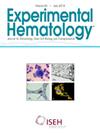细胞通过清道夫受体 B 类 1 型介导的非内皮细胞途径摄取 CPX-351。
IF 2.5
4区 医学
Q2 HEMATOLOGY
引用次数: 0
摘要
脂质体制剂中的药物能否被靶细胞适当吸收,对疗效有显著影响。血清蛋白吸附到脂质体表面后形成的蛋白电晕(PC)会与靶细胞的特定表面受体结合,从而影响药物的吸收途径。我们根据对 CPX-351 的 PC 分析研究了白血病细胞的吸收途径,CPX-351 是一种脂质体,含有阿糖胞苷和达乌比星,两者的增效摩尔比固定为 5:1。采用纳米流液相色谱-串联质谱法分析了与胎牛血清混合的 CPX-351 的 PC。CPX-351在HL-60、K562和THP-1白血病细胞系中的摄取量是通过流式细胞术利用daunorubicin荧光测定的。CPX-351 PC 的主要成分是脂蛋白 A-I 和 A-II,它们与清道夫受体 B 类 1 型(SR-BI)结合,这是一种只吸收脂质体内容物的非内源性途径。SR-BI 在每个细胞中都有表达,其表达与 CPX-351 的吸收相关。抑制凝集素介导的内吞作用和大蛋白吞咽作用可明显降低摄取量。此外,SR-BI 的选择性抑制剂阻滞脂质转运-1(BLT-1)也会降低摄取量;但是,大剂量添加 BLT-1 会显著增加摄取量,与凝胶酶介导的内吞相比,大蛋白吞咽抑制对摄取量的抑制作用更强。BLT-1 以剂量依赖的方式增强了 SR-BI 与脂质体的结合。这些研究结果表明,SR-BI 与 CPX-351 之间的结合增强激活了不同的途径,如大蛋白吞食,这与单独使用 CPX-351 不同。SR-BI可能是CPX-351治疗的生物标志物,CPX-351与高剂量BLT-1的结合可能会增强疗效。本文章由计算机程序翻译,如有差异,请以英文原文为准。
Cellular uptake of CPX-351 by scavenger receptor class B type 1–mediated nonendocytic pathway
The proper uptake of drugs in liposome formulations into target cells markedly impacts therapeutic efficacy. The protein corona (PC), formed by the adsorption of serum proteins onto the liposome surface, binds to specific surface receptors of target cells, influencing the uptake pathway. We investigated the uptake pathway into leukemia cells based on PC analysis of CPX-351, a liposome containing cytarabine and daunorubicin in a fixed 5:1 synergistic molar ratio. The PC of CPX-351 mixed with fetal bovine serum was analyzed by nanoflow liquid chromatography-tandem mass spectrometry. CPX-351 uptake in HL-60, K562, and THP-1 leukemia cell lines was measured by flow cytometry using daunorubicin fluorescence. The major components of CPX-351 PC include apolipoproteins A-I and A-II, which bind to scavenger receptor class B type 1 (SR-BI), a nonendocytic pathway that takes up only liposome contents. SR-BI was expressed in each cell, and its expression correlated with CPX-351 uptake. The uptake was significantly decreased by the inhibition of clathrin-mediated endocytosis and macropinocytosis. Additionally, blocks lipid transport-1 (BLT-1), a selective inhibitor of SR-BI, decreased the uptake; however, high-dose BLT-1 addition significantly increased the uptake, which was more strongly inhibited by macropinocytosis suppression compared with clathrin-mediated endocytosis. BLT-1 enhances the binding of SR-BI to liposomes in a dose-dependent manner. These findings indicate that the enhancement of binding between SR-BI and CPX-351 activates different pathways, such as macropinocytosis, distinct from CPX-351 alone. SR-BI may be a biomarker for CPX-351 therapy, and the combination of CPX-351 with high-dose BLT-1 may augment therapeutic efficacy.
求助全文
通过发布文献求助,成功后即可免费获取论文全文。
去求助
来源期刊

Experimental hematology
医学-血液学
CiteScore
5.30
自引率
0.00%
发文量
84
审稿时长
58 days
期刊介绍:
Experimental Hematology publishes new findings, methodologies, reviews and perspectives in all areas of hematology and immune cell formation on a monthly basis that may include Special Issues on particular topics of current interest. The overall goal is to report new insights into how normal blood cells are produced, how their production is normally regulated, mechanisms that contribute to hematological diseases and new approaches to their treatment. Specific topics may include relevant developmental and aging processes, stem cell biology, analyses of intrinsic and extrinsic regulatory mechanisms, in vitro behavior of primary cells, clonal tracking, molecular and omics analyses, metabolism, epigenetics, bioengineering approaches, studies in model organisms, novel clinical observations, transplantation biology and new therapeutic avenues.
 求助内容:
求助内容: 应助结果提醒方式:
应助结果提醒方式:


